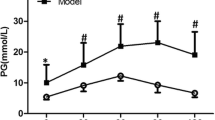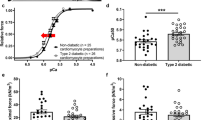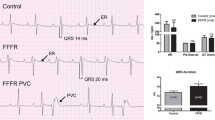Abstract
Chronic pressure-overload and diabetes mellitus are two frequent disorders affecting the heart. We aimed to characterize myocardial structural and functional changes induced by both conditions. Pressure-overload was established in Wistar-han male rats by supra-renal aortic banding. Six-weeks later, diabetes was induced by streptozotocin (65 mg/kg,ip), resulting in four groups: SHAM, banding (BA), diabetic (DM) and diabetic-banding (DB). Six-weeks later, pressure–volume loops were obtained and left ventricular samples were collected to evaluate alterations in insulin signalling pathways, extracellular matrix as well as myofilament function and phosphorylation. Pressure-overload increased cardiomyocyte diameter (BA 22.0 ± 0.4 μm, SHAM 18.2 ± 0.3 μm) and myofilament maximal force (BA 25.7 ± 3.6 kN/m2, SHAM 18.6 ± 1.4 kN/m2), Ca2+ sensitivity (BA 5.56 ± 0.02, SHAM 5.50 ± 0.02) as well as MyBP-C, Akt and Erk phosphorylation, while decreasing rate of force redevelopment (K tr; BA 14.9 ± 1.1 s−1, SHAM 25.2 ± 1.5 s−1). At the extracellular matrix level, fibrosis (BA 10.8 ± 0.9%, SHAM 5.3 ± 0.6%), pro-MMP-2 and MMP-9 activities increased and, in vivo, relaxation was impaired (τ; BA 14.0 ± 0.9 ms, SHAM 12.9 ± 0.4 ms). Diabetes increased cardiomyocyte diameter, fibrosis (DM 21.4 ± 0.4 μm, 13.9 ± 1.8%, DB 20.6 ± 0.4 μm, 13.8 ± 0.8%, respectively), myofilament Ca2+sensitivity (DM 5.57 ± 0.02, DB 5.57 ± 0.01), advanced glycation end-product deposition (DM 4.9 ± 0.6 score/mm2, DB 5.1 ± 0.4 score/mm2, SHAM 2.1 ± 0.3 score/mm2), and apoptosis, while decreasing K tr (DM 13.5 ± 1.9 s−1, DB 15.2 ± 1.4 s−1), Akt phosphorylation and MMP-9/TIMP-1 and MMP-1/TIMP-1 ratios. Diabetic hearts were stiffer (higher end-diastolic-pressure: DM 7.0 ± 1.2 mmHg, DB 6.7 ± 0.7 mmHg, SHAM 5.3 ± 0.4 mmHg, steeper end-diastolic-pressure–volume relation: DM 0.59 ± 0.18, DB 0.83 ± 0.17, SHAM 0.41 ± 0.10), and hypo-contractile (decreased end-systolic-pressure-volume-relation). DB animals presented further pulmonary congestion (Lungs/body-weight: DB 5.23 ± 0.21 g/kg, SHAM 3.80 ± 0.14 g/kg) as this group combined overload-induced relaxation abnormalities and diabetes-induced stiffness. Diabetes mellitus and pressure overload led to distinct diastolic dysfunction phenotypes: while diabetes promoted myocardial stiffening, pressure overload impaired relaxation. The association of these damages accelerates the progression of diastolic heart failure progression in diabetic-banded animals.






Similar content being viewed by others
References
Anversa P, Li P, Malhotra A, Zhang X, Herman MV, Capasso JM (1993) Effects of hypertension and coronary constriction on cardiac function, morphology, and contractile proteins in rats. Am J Physiol 265:H713–H724
Aronson D (2003) Cross-linking of glycated collagen in the pathogenesis of arterial and myocardial stiffening of aging and diabetes. J Hypertens 21:3–12. doi:10.1097/01.hjh.0000042892.24999.92
Berg TJ, Snorgaard O, Faber J, Torjesen PA, Hildebrandt P, Mehlsen J, Hanssen KF (1999) Serum levels of advanced glycation end products are associated with left ventricular diastolic function in patients with type 1 diabetes. Diabetes Care 22:1186–1190. doi:10.2337/diacare.22.7.1186
Borbely A, van der Velden J, Papp Z, Bronzwaer JG, Edes I, Stienen GJ, Paulus WJ (2005) Cardiomyocyte stiffness in diastolic heart failure. Circulation 111:774–781. doi:10.1161/01.CIR.0000155257.33485.6D
Brown RA, Filipovich P, Walsh MF, Sowers JR (1996) Influence of sex, diabetes and ethanol on intrinsic contractile performance of isolated rat myocardium. Basic Res Cardiol 91:353–360. doi:10.1007/BF00788714
Brownlee M, Cerami A, Vlassara H (1988) Advanced glycosylation end products in tissue and the biochemical basis of diabetic complications. N Engl J Med 318:1315–1321. doi:10.1056/NEJM198805193182007
Capasso JM, Palackal T, Olivetti G, Anversa P (1990) Left ventricular failure induced by long-term hypertension in rats. Circ Res 66:1400–1412
DeBosch BJ, Muslin AJ (2008) Insulin signaling pathways and cardiac growth. J Mol Cell Cardiol 44:855–864. doi:10.1016/j.yjmcc.2008.03.008
Dhalla NS, Liu X, Panagia V, Takeda N (1998) Subcellular remodeling and heart dysfunction in chronic diabetes. Cardiovasc Res 40:239–247. doi:10.1016/S0008-6363(98)00186-2
Dubrey SW, Reaveley DR, Seed M, Lane DA, Ireland H, O’Donnell M, O’Connor B, Noble MI, Leslie RD (1994) Risk factors for cardiovascular disease in IDDM. A study of identical twins. Diabetes 43:831–835
Fein FS, Zola BE, Malhotra A, Cho S, Factor SM, Scheuer J, Sonnenblick EH (1990) Hypertensive-diabetic cardiomyopathy in rats. Am J Physiol 258:H793–H805. doi:10.2337/diabetes.43.6.831
Gautel M, Zuffardi O, Freiburg A, Labeit S (1995) Phosphorylation switches specific for the cardiac isoform of myosin binding protein-C: a modulator of cardiac contraction? EMBO J 14:1952–1960
Grossman E, Messerli FH (1996) Diabetic and hypertensive heart disease. Ann Intern Med 125:304–310
Gupta MP (2007) Factors controlling cardiac myosin-isoform shift during hypertrophy and heart failure. J Mol Cell Cardiol 43:388–403. doi:10.1016/j.yjmcc.2007.07.045
Hayashidani S, Tsutsui H, Ikeuchi M, Shiomi T, Matsusaka H, Kubota T, Imanaka-Yoshida K, Itoh T, Takeshita A (2003) Targeted deletion of MMP-2 attenuates early LV rupture and late remodeling after experimental myocardial infarction. Am J Physiol Heart Circ Physiol 285:H1229–H1235. doi:10.1152/ajpheart.00207.2003
Hessel MH, Steendijk P, den Adel B, Schutte CI, van der Laarse A (2006) Characterization of right ventricular function after monocrotaline-induced pulmonary hypertension in the intact rat. Am J Physiol Heart Circ Physiol 291:H2424–H2430. doi:10.1152/ajpheart.00369.2006
Heusch G (2009) Diastolic heart failure: a misNOmer. Basic Res Cardiol 104:465–467. doi:10.1007/s00395-009-0025-3
Heymans S, Luttun A, Nuyens D, Theilmeier G, Creemers E, Moons L, Dyspersin GD, Cleutjens JP, Shipley M, Angellilo A, Levi M, Nube O, Baker A, Keshet E, Lupu F, Herbert JM, Smits JF, Shapiro SD, Baes M, Borgers M, Collen D, Daemen MJ, Carmeliet P (1999) Inhibition of plasminogen activators or matrix metalloproteinases prevents cardiac rupture but impairs therapeutic angiogenesis and causes cardiac failure. Nat Med 5:1135–1142. doi:10.1038/13459
Huang J, Shelton JM, Richardson JA, Kamm KE, Stull JT (2008) Myosin regulatory light chain phosphorylation attenuates cardiac hypertrophy. J Biol Chem 283:19748–19756. doi:10.1074/jbc.M802605200
Ihm SH, Chang K, Kim HY, Baek SH, Youn HJ, Seung KB, Kim JH (2010) Peroxisome proliferator-activated receptor-gamma activation attenuates cardiac fibrosis in type 2 diabetic rats: the effect of rosiglitazone on myocardial expression of receptor for advanced glycation end products and of connective tissue growth factor. Basic Res Cardiol 105:399–407. doi:10.1007/s00395-009-0071-x
Junqueira LC, Bignolas G, Brentani RR (1979) Picrosirius staining plus polarization microscopy, a specific method for collagen detection in tissue sections. Histochem J 11:447–455. doi:10.1007/BF01002772
Kleinbongard P, Heusch G, Schulz R (2010) TNFalpha in atherosclerosis, myocardial ischemia/reperfusion and heart failure. Pharmacol Ther 127:295–314. doi:10.1016/j.pharmthera.2010.05.002
Leite-Moreira AF (2006) Current perspectives in diastolic dysfunction and diastolic heart failure. Heart 92:712–718. doi:10.1136/hrt.2005.062950
Li Q, Sun SZ, Wang Y, Tian YJ, Liu MH (2007) The roles of MMP-2/TIMP-2 in extracellular matrix remodelling in the hearts of STZ-induced diabetic rats. Acta Cardiol 62:485–491. doi:10.2143/AC.62.5.2023412
Litwin SE, Raya TE, Anderson PG, Daugherty S, Goldman S (1990) Abnormal cardiac function in the streptozotocin-diabetic rat Changes in active and passive properties of the left ventricle. J Clin Invest 86:481–488. doi:10.1172/JCI114734
McClellan G, Kulikovskaya I, Winegrad S (2001) Changes in cardiac contractility related to calcium-mediated changes in phosphorylation of myosin-binding protein C. Biophys J 81:1083–1092. doi:10.1016/S0006-3495(01)75765-7
Nagatomo Y, Carabello BA, Coker ML, McDermott PJ, Nemoto S, Hamawaki M, Spinale FG (2000) Differential effects of pressure or volume overload on myocardial MMP levels and inhibitory control. Am J Physiol Heart Circ Physiol 278:H151–H161
Perlini S, Palladini G, Ferrero I, Tozzi R, Fallarini S, Facoetti A, Nano R, Clari F, Busca G, Fogari R, Ferrari AU (2005) Sympathectomy or doxazosin, but not propranolol, blunt myocardial interstitial fibrosis in pressure-overload hypertrophy. Hypertension 46:1213–1218
Polyakova V, Hein S, Kostin S, Ziegelhoeffer T, Schaper J (2004) Matrix metalloproteinases and their tissue inhibitors in pressure-overloaded human myocardium during heart failure progression. J Am Coll Cardiol 44:1609–1618. doi:10.1016/j.jacc.2004.07.023
Poornima IG, Parikh P, Shannon RP (2006) Diabetic cardiomyopathy: the search for a unifying hypothesis. Circ Res 98:596–605. doi:10.1161/01.RES.0000207406.94146.c2
Regan TJ, Khan MI, Ettinger PO, Haider B, Lyons MM, Oldewurtel HA (1974) Myocardial function and lipid metabolism in the chronic alcoholic animal. J Clin Invest 54:740–752. doi:10.1172/JCI107812
Ren J, Davidoff AJ (1997) Diabetes rapidly induces contractile dysfunctions in isolated ventricular myocytes. Am J Physiol 272:H148–H158
Riva E, Andreoni G, Bianchi R, Latini R, Luvara G, Jeremic G, Traquandi C, Tuccinardi L (1998) Changes in diastolic function and collagen content in normotensive and hypertensive rats with long-term streptozotocin-induced diabetes. Pharmacol Res 37:233–240. doi:10.1006/phrs.1998.0290
Rodgers RL, Davidoff AJ, Mariani MJ (1991) Cardiac function of the diabetic renovascular hypertensive rat: effects of insulin and thyroid hormone treatment. Can J Physiol Pharmacol 69:346–354. doi:10.1139/y91-053
Sadayappan S, Gulick J, Osinska H, Martin LA, Hahn HS, Dorn GW 2nd, Klevitsky R, Seidman CE, Seidman JG, Robbins J (2005) Cardiac myosin-binding protein-C phosphorylation and cardiac function. Circ Res 97:1156–1163. doi:10.1161/01.RES.0000190605.79013.4d
Sakata Y, Chancey AL, Divakaran VG, Sekiguchi K, Sivasubramanian N, Mann DL (2008) Transforming growth factor-beta receptor antagonism attenuates myocardial fibrosis in mice with cardiac-restricted overexpression of tumor necrosis factor. Basic Res Cardiol 103:60–68. doi:10.1007/s00395-007-0689-5
Schalkwijk CG, Baidoshvili A, Stehouwer CD, van Hinsbergh VW, Niessen HW (2004) Increased accumulation of the glycoxidation product Nepsilon-(carboxymethyl)lysine in hearts of diabetic patients: generation and characterisation of a monoclonal anti-CML antibody. Biochim Biophys Acta 1636:82–89
Spinale FG (2002) Matrix metalloproteinases: regulation and dysregulation in the failing heart. Circ Res 90:520–530. doi:10.1016/S0008-6363(99)00431-9
Spinale FG, Coker ML, Bond BR, Zellner JL (2000) Myocardial matrix degradation and metalloproteinase activation in the failing heart: a potential therapeutic target. Cardiovasc Res 46:225–238. doi:10.1016/S0008-6363(99)00431-9
Sweeney HL, Bowman BF, Stull JT (1993) Myosin light chain phosphorylation in vertebrate striated muscle: regulation and function. Am J Physiol 264:C1085–C1095
Tomlinson KC, Gardiner SM, Hebden RA, Bennett T (1992) Functional consequences of streptozotocin-induced diabetes mellitus, with particular reference to the cardiovascular system. Pharmacol Rev 44:103–150
Tozzi R, Palladini G, Fallarini S, Nano R, Gatti C, Presotto C, Schiavone A, Micheletti R, Ferrari P, Fogari R, Perlini S (2007) Matrix metalloprotease activity is enhanced in the compensated but not in the decompensated phase of pressure overload hypertrophy. Am J Hypertens 20:663–669. doi:10.1016/j.amjhyper.2007.01.016
van Heerebeek L, Borbely A, Niessen HW, Bronzwaer JG, van der Velden J, Stienen GJ, Linke WA, Laarman GJ, Paulus WJ (2006) Myocardial structure and function differ in systolic and diastolic heart failure. Circulation 113:1966–1973. doi:10.1161/CIRCULATIONAHA.105.587519
van Hoeven KH, Factor SM (1990) A comparison of the pathological spectrum of hypertensive, diabetic, and hypertensive-diabetic heart disease. Circulation 82:848–855
Van Linthout S, Seeland U, Riad A, Eckhardt O, Hohl M, Dhayat N, Richter U, Fischer JW, Bohm M, Pauschinger M, Schultheiss HP, Tschope C (2008) Reduced MMP-2 activity contributes to cardiac fibrosis in experimental diabetic cardiomyopathy. Basic Res Cardiol 103:319–327. doi:10.1007/s00395-008-0715-2
Volz HC, Seidel C, Laohachewin D, Kaya Z, Muller OJ, Pleger ST, Lasitschka F, Bianchi ME, Remppis A, Bierhaus A, Katus HA, Andrassy M (2010) HMGB1: the missing link between diabetes mellitus and heart failure. Basic Res Cardiol 105:805–820. doi:10.1007/s00395-010-0114-3
Weisberg A, Winegrad S (1998) Relation between crossbridge structure and actomyosin ATPase activity in rat heart. Circ Res 83:60–72
Whittaker P, Kloner RA, Boughner DR, Pickering JG (1994) Quantitative assessment of myocardial collagen with picrosirius red staining and circularly polarized light. Basic Res Cardiol 89:397–410. doi:10.1007/BF00788278
Wiesner RJ, Ehmke H, Faulhaber J, Zak R, Ruegg JC (1997) Dissociation of left ventricular hypertrophy, beta-myosin heavy chain gene expression, and myosin isoform switch in rats after ascending aortic stenosis. Circulation 95:1253–1259
Yang B, Larson DF, Watson R (1999) Age-related left ventricular function in the mouse: analysis based on in vivo pressure-volume relationships. Am J Physiol 277:H1906–H1913
Zaremba R, Merkus D, Hamdani N, Lamers JML, Paulus WJ, dos Remedios C, Duncker DJ, Stienen GJM, van der Velden J (2007) Quantitative analysis of myofilament protein phosphorylation in small cardiac biopsies. Proteomics Clin Appl 1:1285. doi:10.1002/prca.200600891
Zile MR, Baicu CF, Gaasch WH (2004) Diastolic heart failure–abnormalities in active relaxation and passive stiffness of the left ventricle. N Engl J Med 350:1953–1959. doi:10.1056/NEJMoa032566
Acknowledgments
The authors would like to thank Doctor José Magalhães and his group for kindly providing anti-Bax and anti-Bcl-2 antibodies. This work was supported by the Portuguese Foundation for Science and Technology (grant number PIC/IC/82943/2007) through the Cardiovascular R&D Unit (FCT nr. 51/94) and by the European Union Project FP7-HEALTH-2010: “MEDIA-Metabolic Road to Diastolic Heart Failure”. #HEALTH. 2010.2.4.2-4.
Conflict of interest
None.
Author information
Authors and Affiliations
Corresponding author
Rights and permissions
About this article
Cite this article
Falcão-Pires, I., Palladini, G., Gonçalves, N. et al. Distinct mechanisms for diastolic dysfunction in diabetes mellitus and chronic pressure-overload. Basic Res Cardiol 106, 801–814 (2011). https://doi.org/10.1007/s00395-011-0184-x
Received:
Revised:
Accepted:
Published:
Issue Date:
DOI: https://doi.org/10.1007/s00395-011-0184-x




